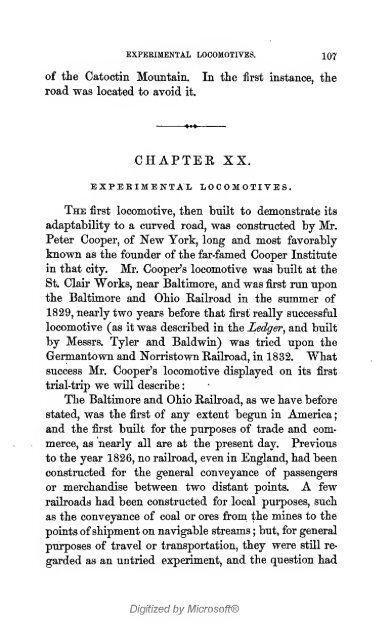The history of the first locomotives in America. From original ...
The history of the first locomotives in America. From original ...
The history of the first locomotives in America. From original ...
You also want an ePaper? Increase the reach of your titles
YUMPU automatically turns print PDFs into web optimized ePapers that Google loves.
EXPERIMENTAL LOCOMOTIVES. IQ?<br />
<strong>of</strong> <strong>the</strong> Catoct<strong>in</strong> Mounta<strong>in</strong>. In <strong>the</strong> <strong>first</strong> <strong>in</strong>stance, <strong>the</strong><br />
road was located to avoid it.<br />
:<br />
CHAPTEK XX.<br />
EXPEEIMENTAL LOCOMOTIVES.<br />
<strong>The</strong> <strong>first</strong> locomotive, <strong>the</strong>n bnilt to demonstrate its<br />
adaptability to a curved road, was constructed by Mr.<br />
Peter Cooper, <strong>of</strong> New York, long and most favorably<br />
known as <strong>the</strong> founder <strong>of</strong> <strong>the</strong> far-famed Cooper Institute<br />
<strong>in</strong> that city. Mr, Cooper's locomotive was built at <strong>the</strong><br />
St. Clair Works, near Baltimore, and was <strong>first</strong> run upon<br />
<strong>the</strong> Baltimore and Ohio Railroad <strong>in</strong> <strong>the</strong> summer <strong>of</strong><br />
1829, nearly two years before that <strong>first</strong> really successful<br />
locomotive (as it was described <strong>in</strong> <strong>the</strong> Ledger^ and built<br />
by Messrs. Tyler and Baldw<strong>in</strong>) was tried upon <strong>the</strong><br />
Germantown and Norristown Eailroad, <strong>in</strong> 1832. What<br />
success Mr. Cooper's locomotive displayed on its <strong>first</strong><br />
trial-trip we will describe<br />
<strong>The</strong> Baltimore and Ohio Railroad, as we have before<br />
stated, was <strong>the</strong> <strong>first</strong> <strong>of</strong> any extent begun <strong>in</strong> <strong>America</strong><br />
and <strong>the</strong> <strong>first</strong> built for <strong>the</strong> purposes <strong>of</strong> trade and com-<br />
merce, as nearly all are at <strong>the</strong> present day. Previous<br />
to <strong>the</strong> year 1826, no railroad, even <strong>in</strong> England, had been<br />
constructed for <strong>the</strong> general conveyance <strong>of</strong> passengers<br />
or merchandise between two distant po<strong>in</strong>ts. A few<br />
railroads had been constructed for local purposes, such<br />
as <strong>the</strong> conveyance <strong>of</strong> coal or ores from, <strong>the</strong> m<strong>in</strong>es to <strong>the</strong><br />
po<strong>in</strong>ts <strong>of</strong> shipment on navigable streams ; but, for general<br />
purposes <strong>of</strong> travel or transportation, <strong>the</strong>y were still re-<br />
garded as an untried experiment, and <strong>the</strong> question had<br />
Digitized by Micros<strong>of</strong>t®<br />
;
















